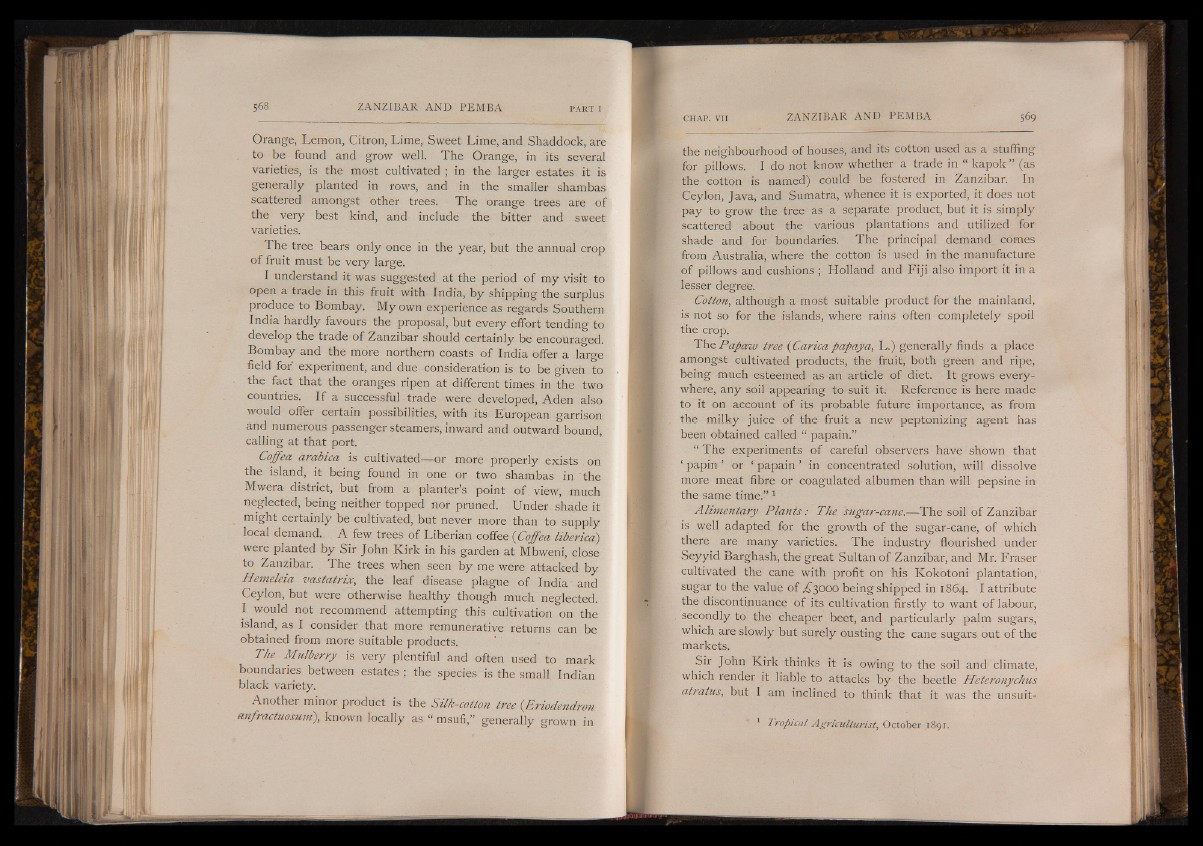
Orange, Lemon, Citron, Lime, Sweet Lime, and Shaddock, are
to be found and grow well. The Orange, in its several
varieties, is the most cultivated ; in the larger estates it is
generally planted in rows, and in the smaller shambas
scattered amongst other trees. The orange trees are of
the very best kind, and include the bitter and sweet
varieties.
The tree bears only once in the year, but the annual crop
of fruit must be very large.
I understand it was suggested at the period of my visit to
open a trade in this fruit with India, by shipping the surplus
produce to Bombay. My own experience as regards Southern
India hardly favours the proposal, but every effort tending to
develop the trade of Zanzibar should certainly be encouraged.
Bombay and the more northern coasts of India offer a large
field for experiment, and due consideration is to be given to
the fact that the oranges ripen at different times in the two
countries. I f a successful trade were developed, Aden also
would offer certain possibilities, with its European garrison
and numerous passenger steamers, inward and outward bound,
calling at that port.
Coffea arabica is cultivated— or more properly exists on
the island, it being found in one or two shambas in the
Mwera district, but from a planter’s point of view, much
neglected, being neither topped nor pruned. Under shade it
might certainly be cultivated, but never more than to supply
local demand. A few trees of Liberian coffee (Coffea liberica)
were planted by Sir John Kirk in his garden at Mbweni, close
to Zanzibar. The trees when seen by me were attacked by
Hemeleia vastatrix, the leaf disease plague of India'and
Ceylon, but were otherwise healthy though much neglected.
I would not recommend attempting this cultivation on the
island, as I consider that more remunerative returns can be
obtained from more suitable products.
The Mulberry is very plentiful and often used to mark
boundaries between estates ; the species is the small Indian
black variety.
Another minor product is the Silk-cotton tree (Eriodendron
anfractuosum), known locally as “ msufi,” generally grown in
the neighbourhood of houses, and its cotton used as a stuffing
for pillows. I do not know whether a trade in kapok ” (as
the cotton is named) could be fostered in Zanzibar. In
Ceylon, Java, and Sumatra, whence it is exported, it does not
pay to grow the tree as a separate product, but it is simply
scattered about the various plantations and utilized for
shade and for boundaries. The principal demand, comes
from Australia, where the cotton is used in the manufacture
of pillows and cushions; Holland and Fiji also import it in a
lesser degree.
Cotton, although a most suitable product for the mainland,
is not so for the islands, where rains often completely spoil
the crop.
The Papaw tree (C.arica papaya, L.) generally finds a place
amongst cultivated products, the fruit, both green and ripe,
being much esteemed as an article of diet. It grows everywhere,
any soil appearing to suit it. Reference is here made
to it on account of its probable future importance, as from
the milky juice of the fruit a new peptonizing agent has
been obtained called “ papain.”
“ The experiments of careful observers have shown that
‘ papin ’ or ‘ papain ’ in concentrated solution, will dissolve
more meat fibre or coagulated albumen than will pepsine in
the same time.” 1
Alimentary Plants: The sugar-cane.— The soil of Zanzibar
is well adapted for the growth of the sugar-cane, of which
there are many varieties. The industry flourished under
Seyyid Barghash, the great Sultan of Zanzibar, and Mr. Fraser
cultivated the cane with profit on his Kokotoni plantation,
sugar to the value of £3000 being shipped in 1864. I attribute
the discontinuance of its cultivation firstly to want of labour,
secondly to the cheaper beet, and particularly palm sugars,;
which are slowly but surely ousting the cane sugars out of the
markets.
Sir John Kirk thinks it is owing to the soil and climate,
which render it liable to attacks by the beetle Heteronychus
atratus, but I am inclined to think that it was the unsuit-
1 tropical Agriculturist, October 1891.